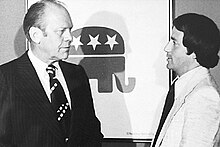Republican National Hispanic Assembly
As one participant, Francisco Vega, later recalled: "... the meeting came about by word of mouth... we were from Florida, California, Texas, New Jersey, Michigan, and several other states...." The purpose of the gathering was to discuss how they could increase Hispanic political involvement.
[1] Having had their offers to organize some kind of Hispanic outreach rebuffed by both the Democratic and Republican Party's national offices, the dejected group returned to their hotel.
Eventually, the gathering dwindled down to five: Ben Fernandez, Manuel Lujan, Fernando Oaxaca, Martin Castillo, and Vega.
These last attendees continued to talk, bonded over their common World War II service and political ideologies, and, eventually, formed the Republican National Hispanic Council.
[1][2][3] Without formal acknowledgment from the Republican Party, the group immediately began to organize chapters in their home and surrounding states.
In addition to others, key RNHA personnel were tapped to assist in this endeavor and the Spanish Speaking Committee for the Re-Election of President Nixon was formed.
This committee has been credited an integral role in garnering more than 35% of the Hispanic vote for the President- a vast improvement over the previous three election cycles where the Republican candidate averaged only 10%.
[4] Additionally, Fernandez and Vega occupied several important positions within Nixon's re-election campaign, in particular, the Hispanic Finance Committee.
[2][5] Later that year, newly appointed RNC chairman George H. W. Bush began to lay the groundwork for a more permanent organization to woo and retain Hispanic voters.
The leaders of several prominent Republican and Republican-leaning Hispanic organizations- including the RNHA- complained in a March 6 letter to RNC chairman Michael Steele of the situation.
